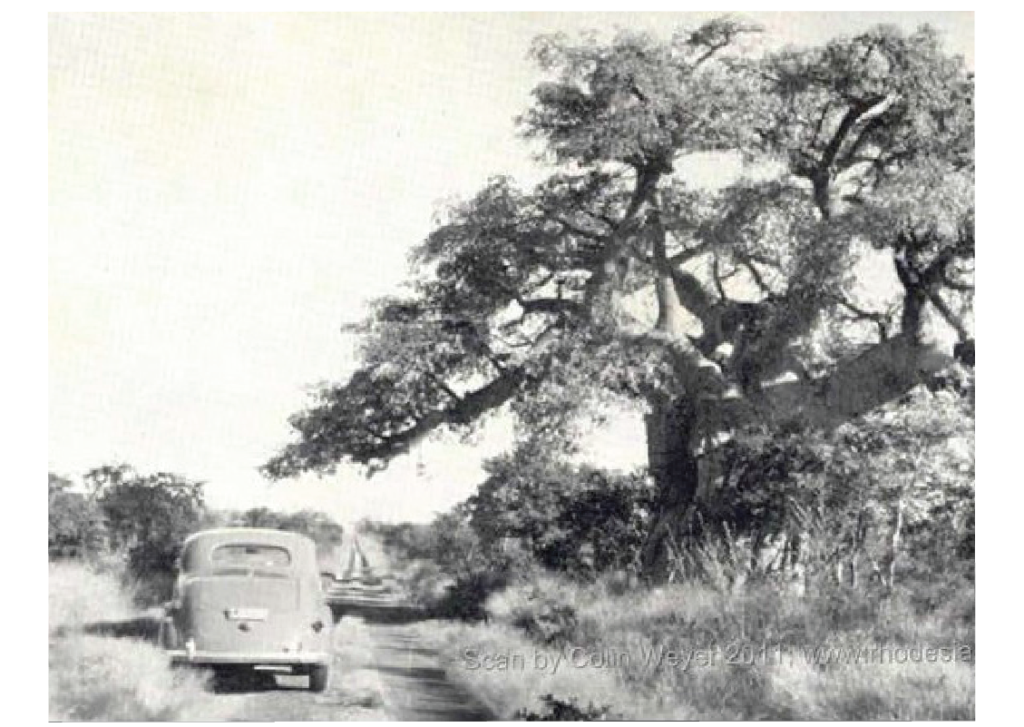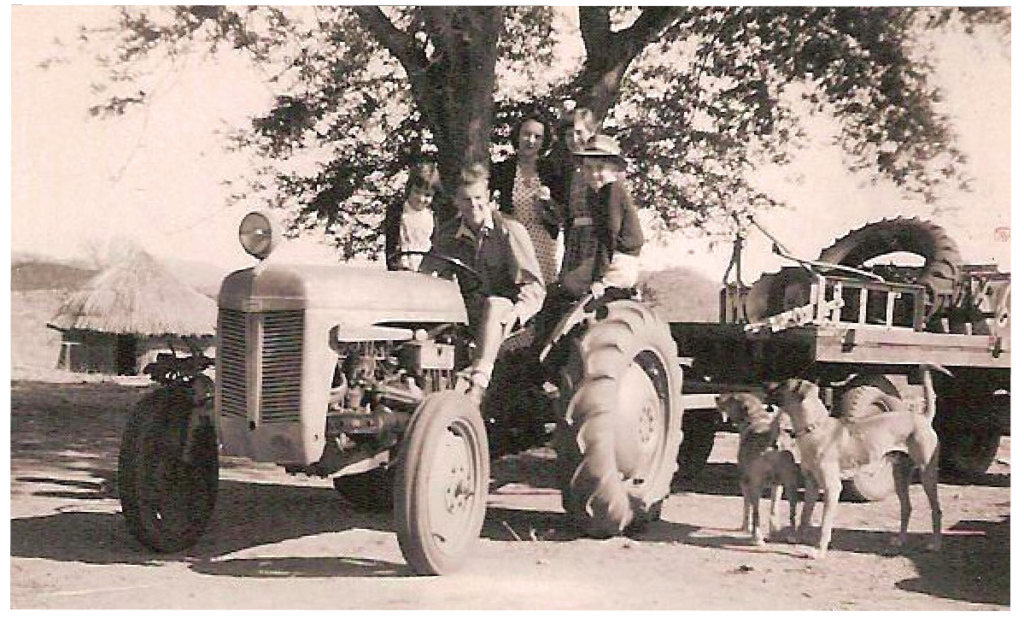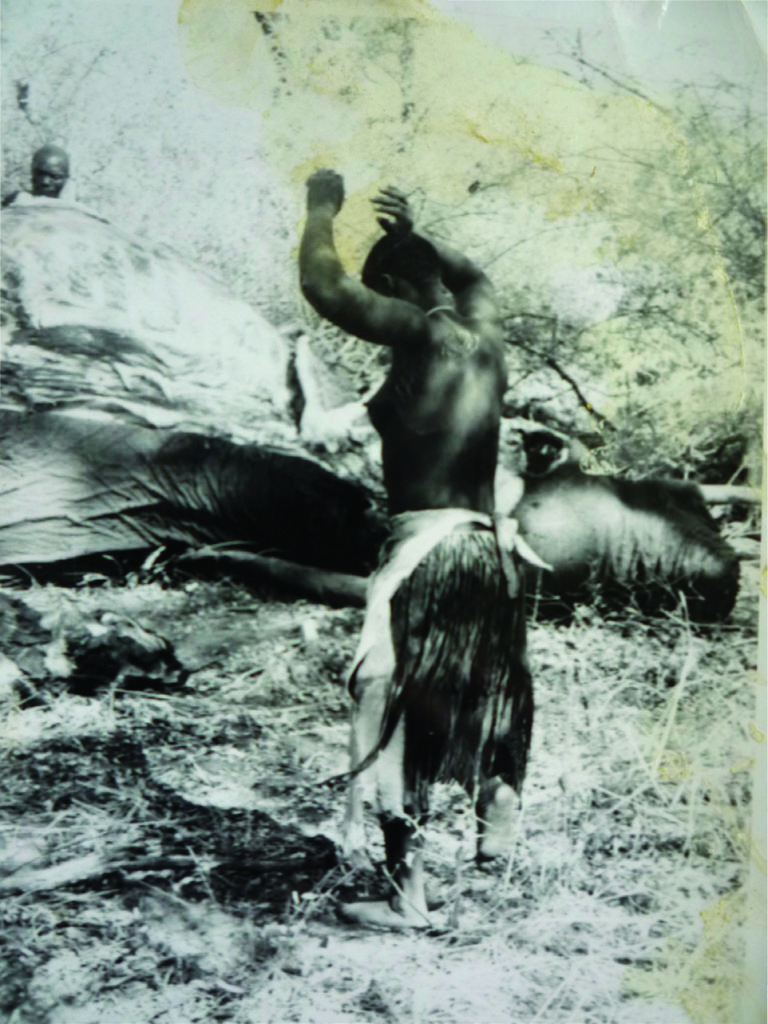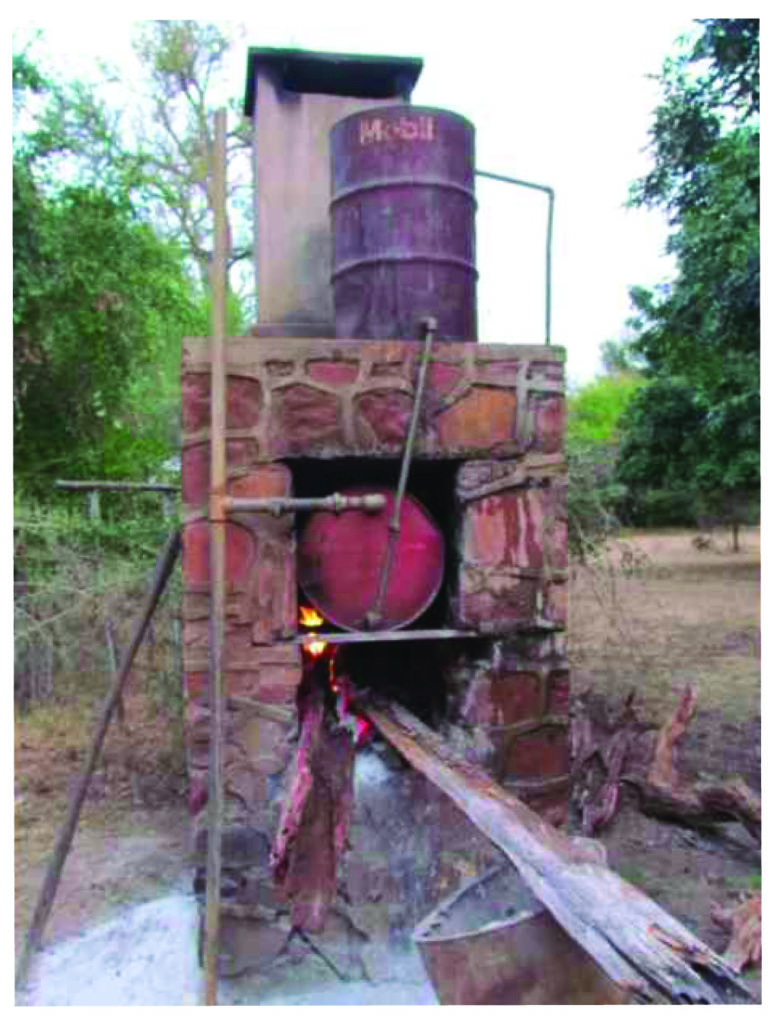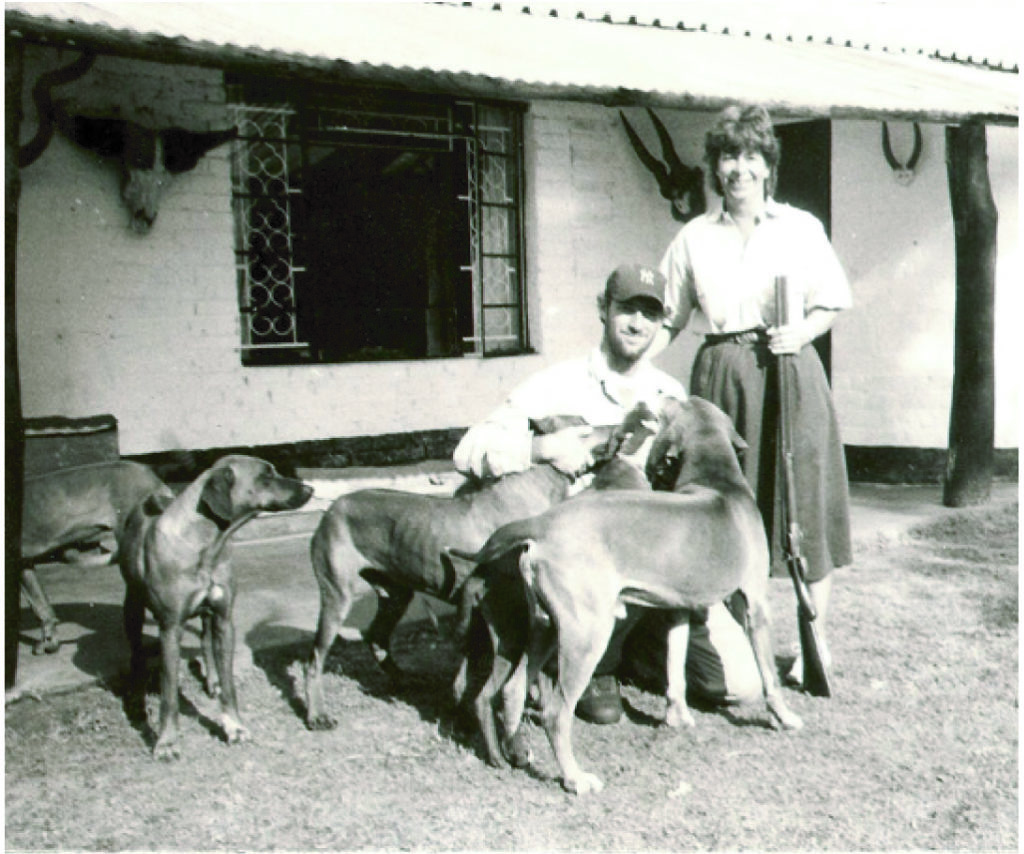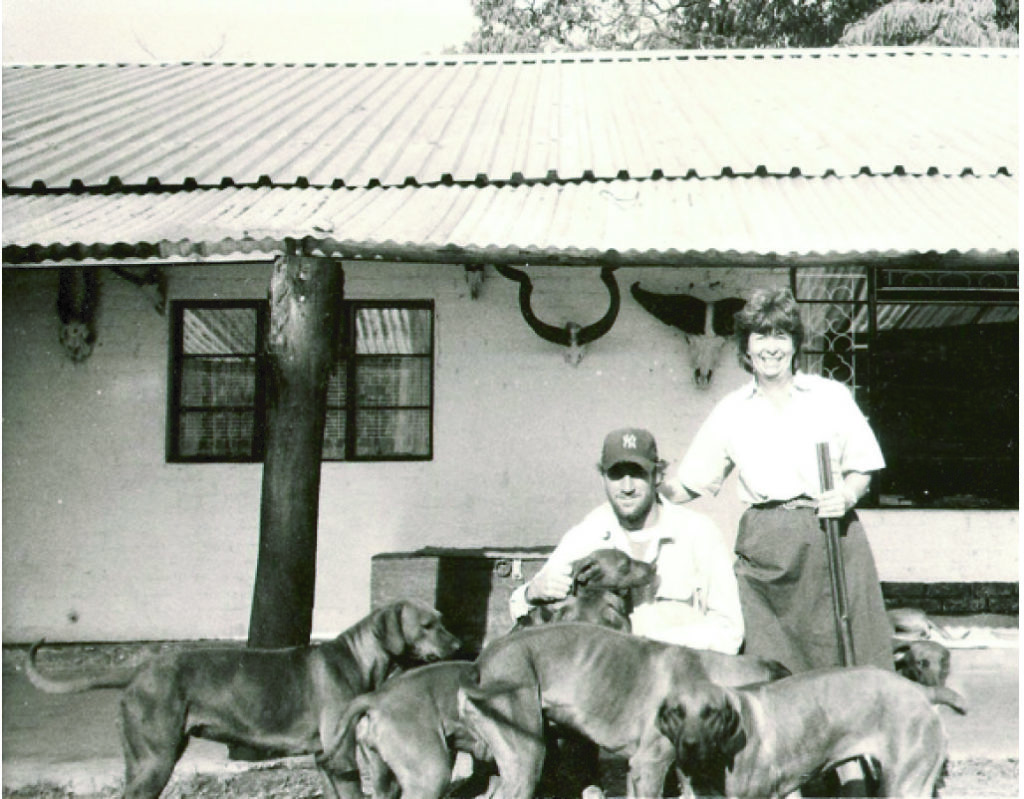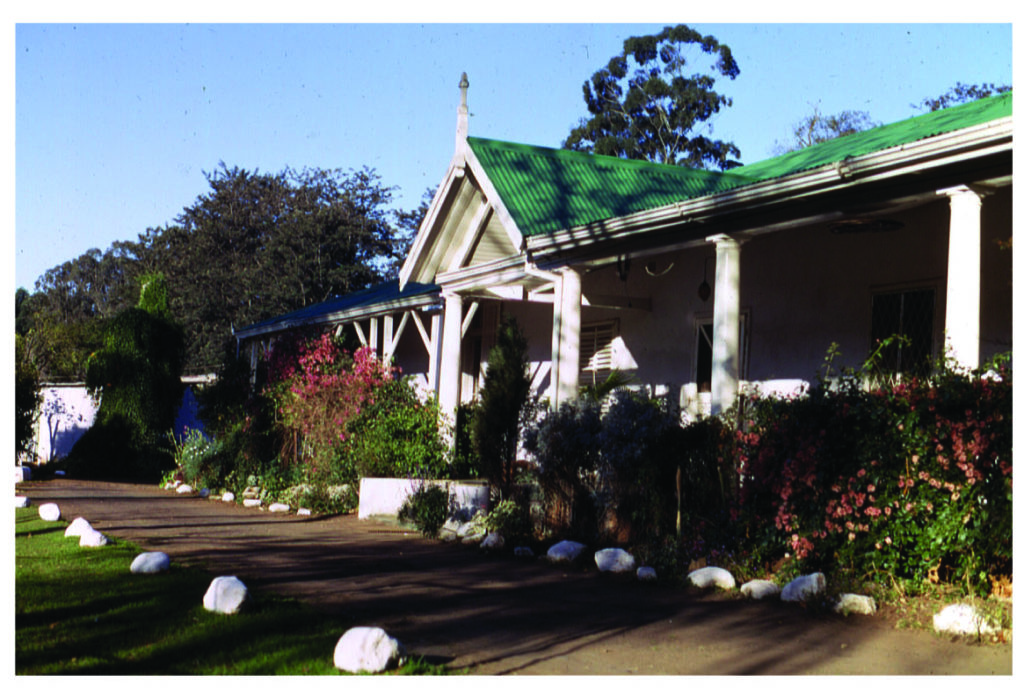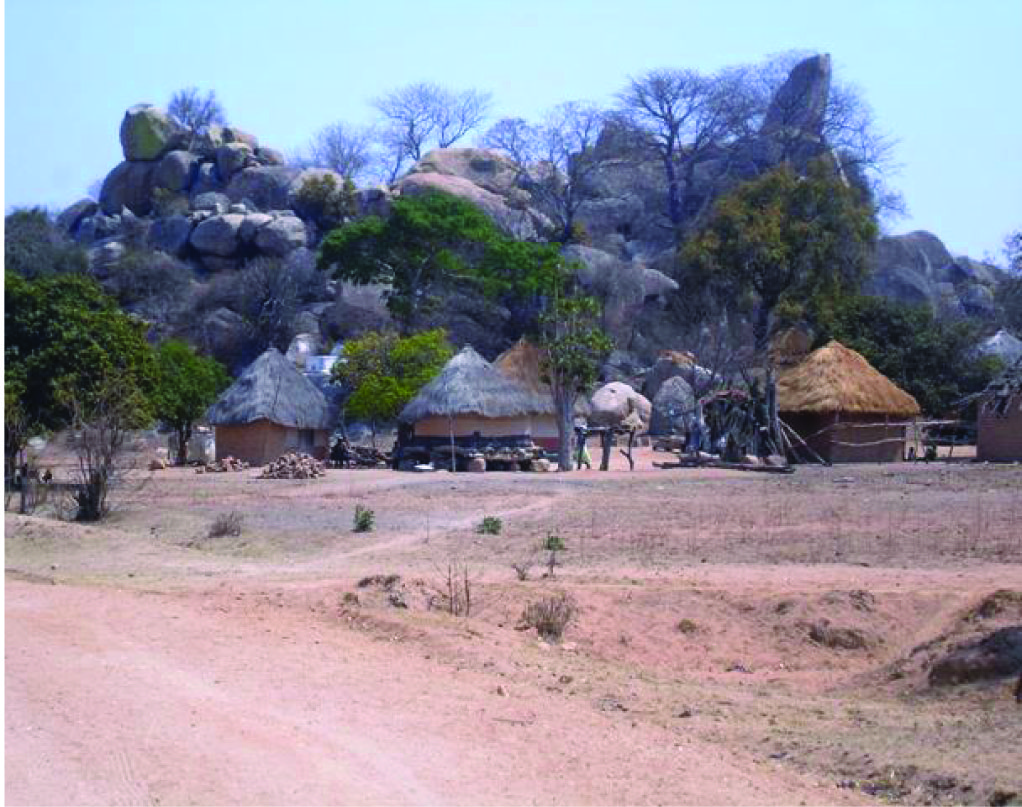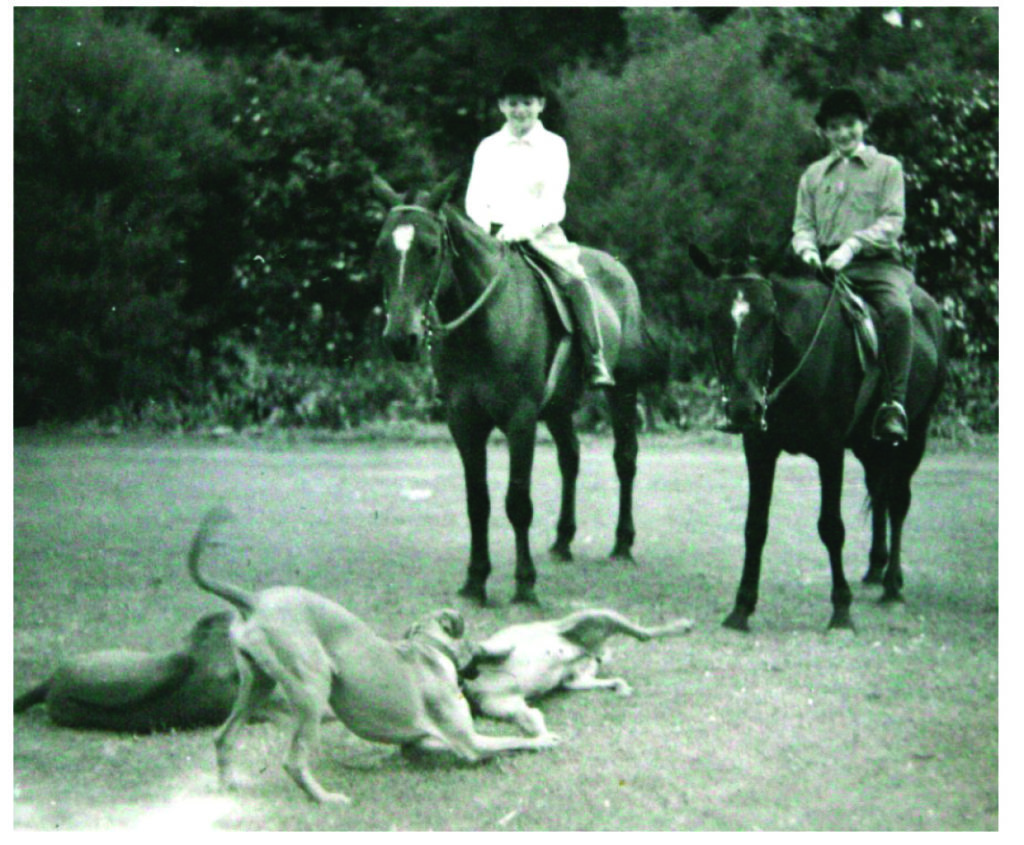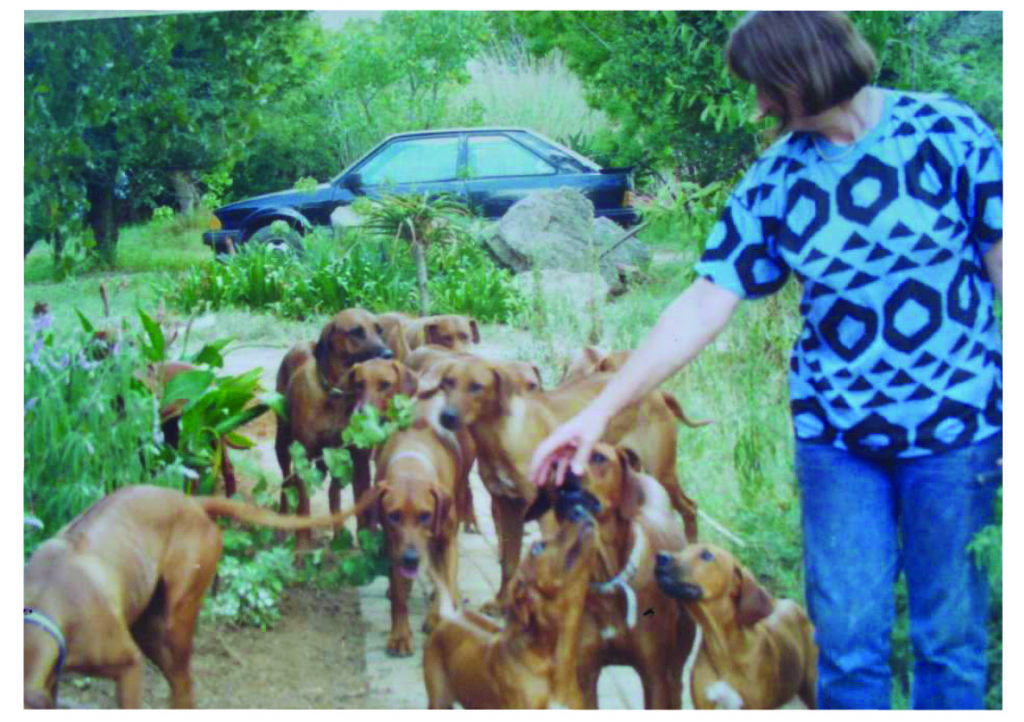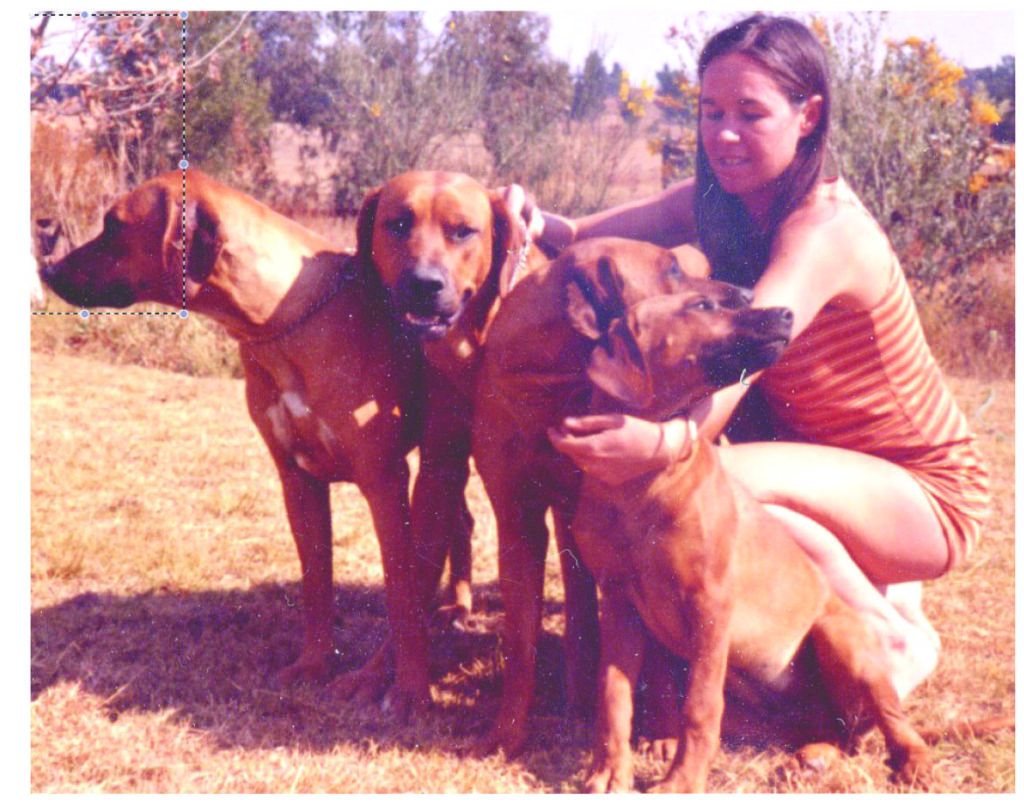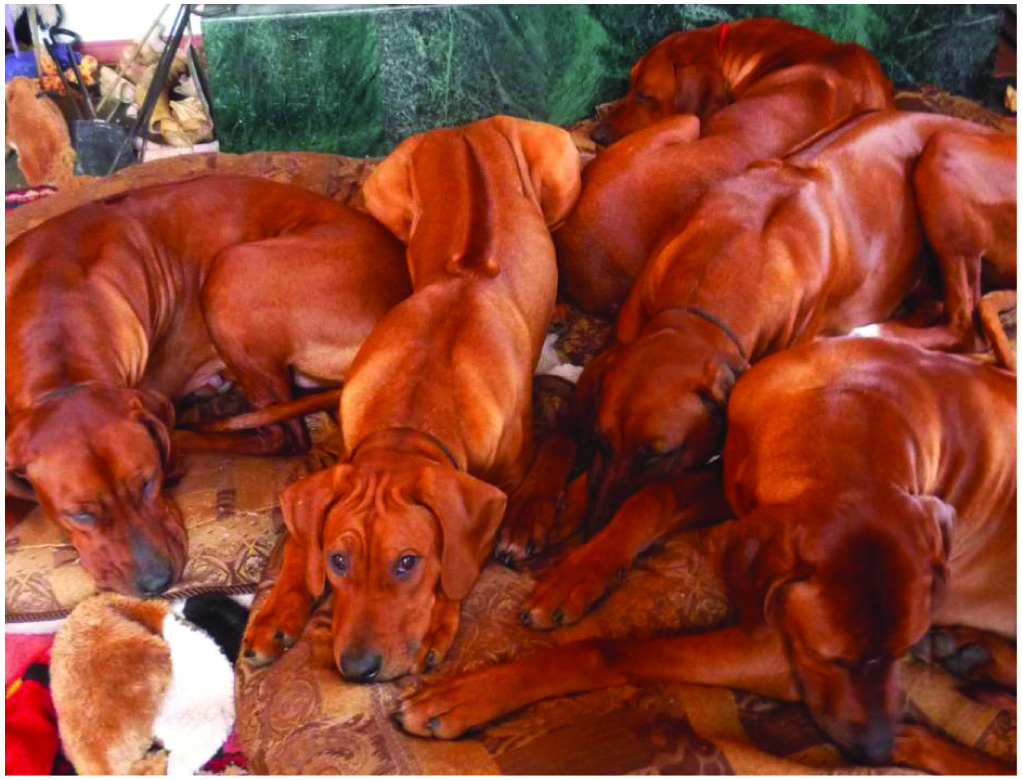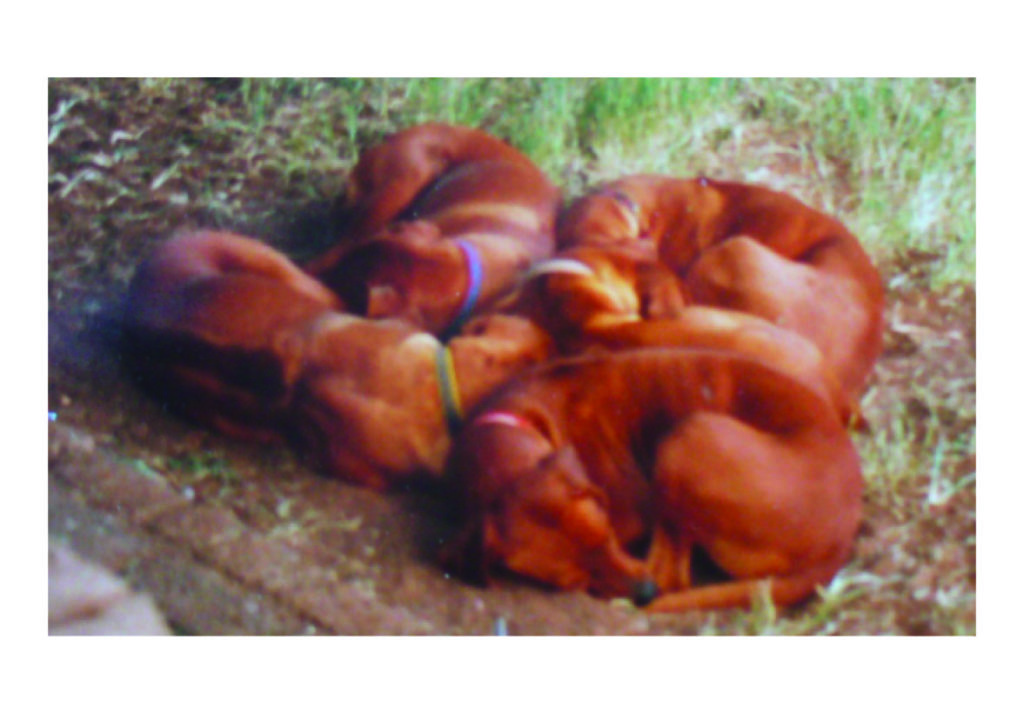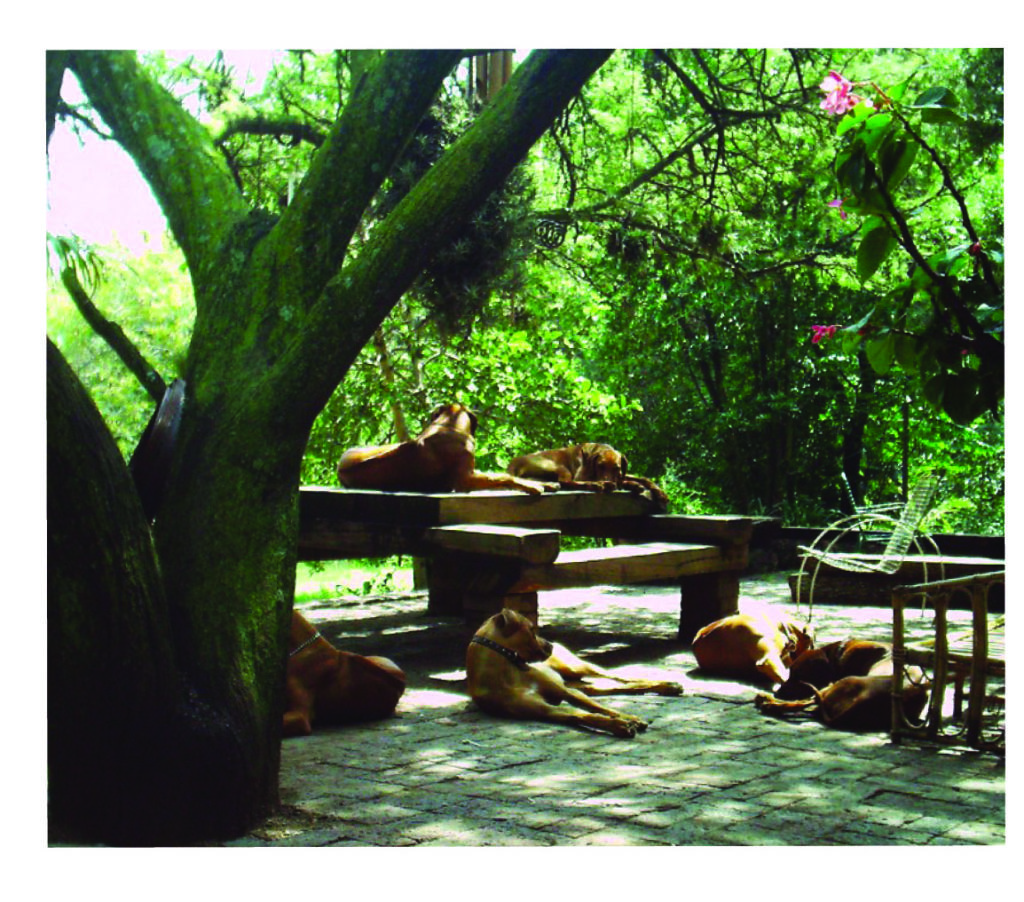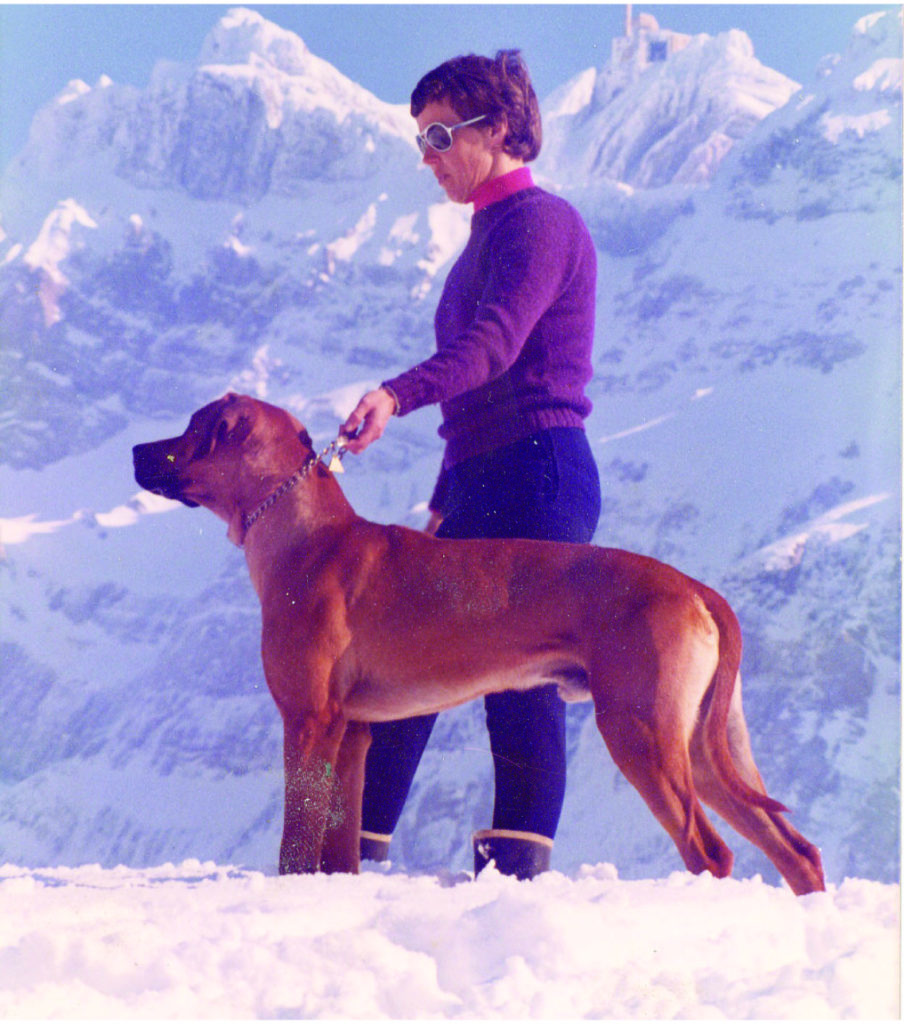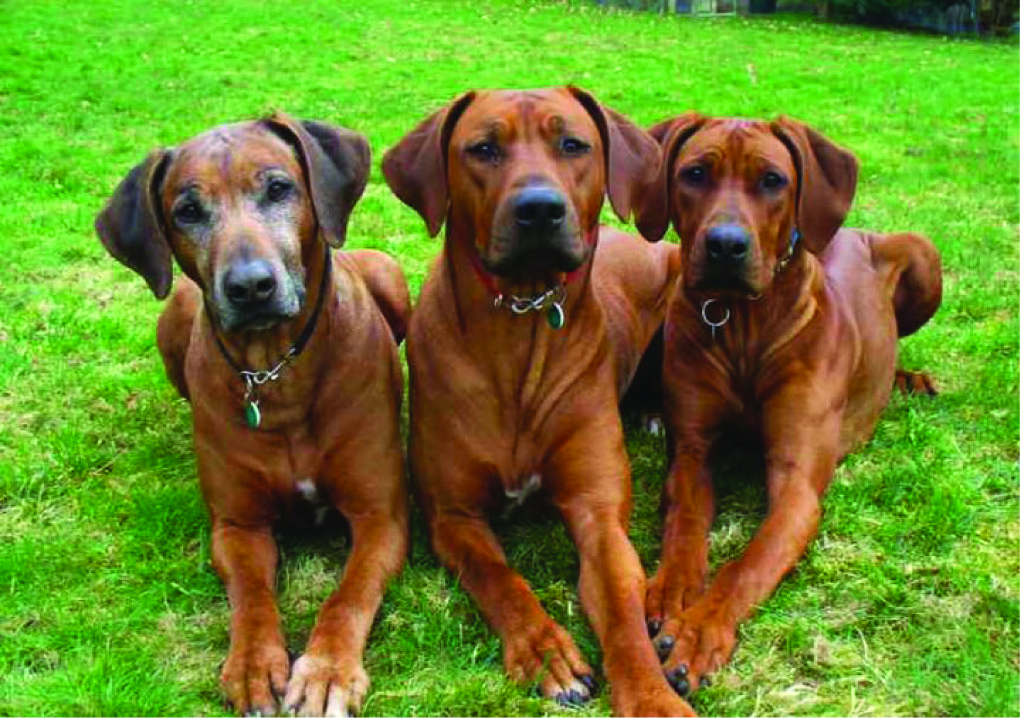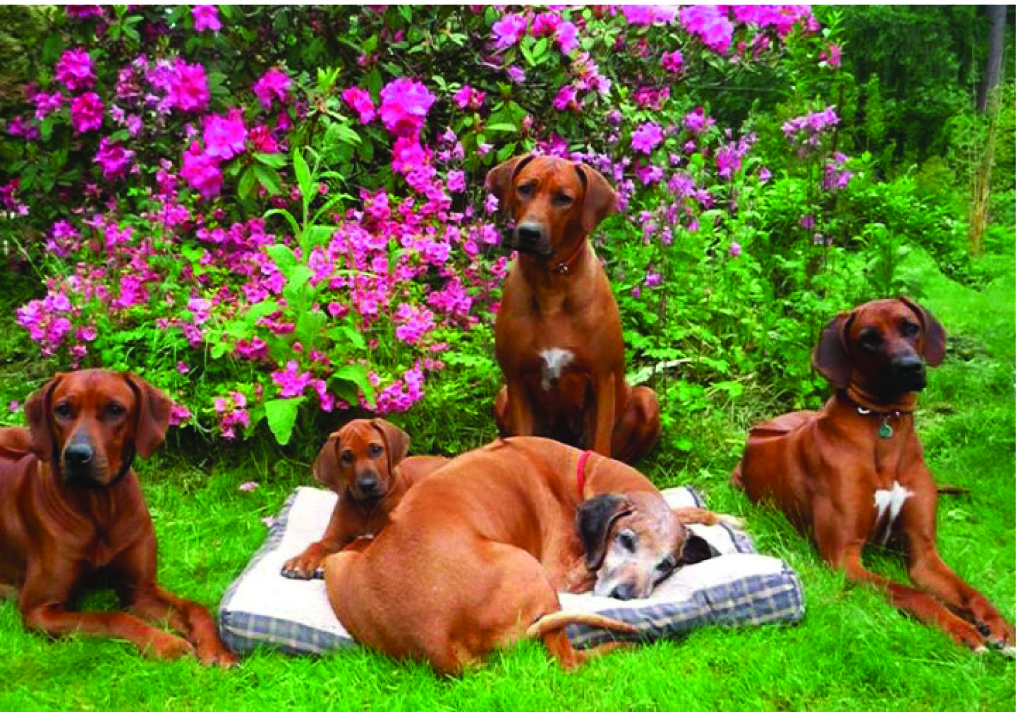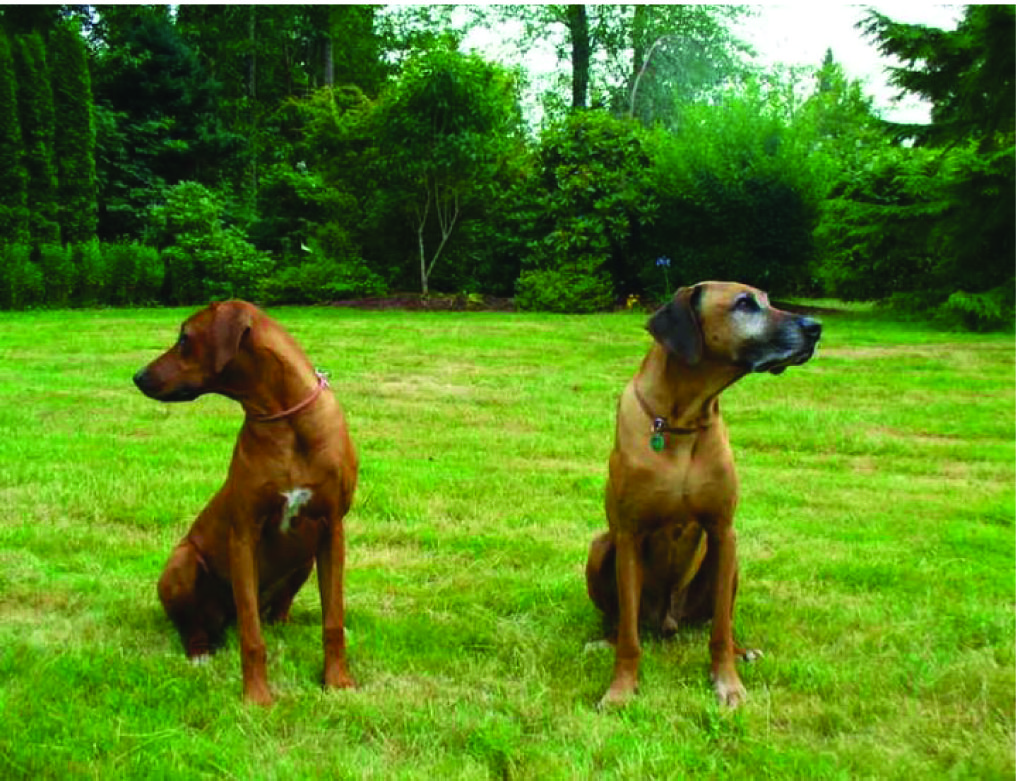Published in The European Ridgeback winter issue 2013.
Images and text by Norah Ormerod.
Sitting here near Seattle, Washington State, USA I look at my 4 Glenaholm RRs and my heart sings at their beauty and think of the long road I took from the 1st time I ever saw a RR in Rhodesia and then the 1st time I saw Rhd+SA Ch Glenaholm Strauss of Inkabusi at Glenaholm, the family home of Mrs McCarthy and her daughter Lau- rie, in the early ‘60s.
I was born in South Africa but my family moved to Rhodesia in 1950. We traveled by train for 4 days as the roads were not very good at all.
I went to a boarding school where children from nearby farms would go home over the weekends. There was hardly a time that I wasn’t in- vited to enjoy the country life with them.
The farms were thousands of acres but only a small portion would be cultivated. There was no electricity. Some farms had generators but they were always turned off at about 9pm and we used hurricane lamps to read or would lie under our mosquito nets and watch the spi- ders, lizards and chameleons in the open thatch above us. These were just part of life and we were not scared of them at all. There were wood burning stoves to cook
which made the kitchens terrible hot in the summers. Water was brought up from underground by windmills, pumped into big round concrete reservoirs and then gravity fed down to the house. These reservoirs were our swimming pools where we would breast stroke through the green slime that grew on the top of the water.
The lavatories were ‘long drops’ out the back down a path which was very scary to travel at night not knowing what was out there. I was al- ways scared that a scorpion would come up and bite me on the bot- tom. We and the African children would wander the farm barefooted with the dogs tagging along with no one worrying about us.
Rhodesia was the ‘land of milk and honey’ but still wild and living there was always full of adventure, whether it would be driving down a ‘strip’ road and suddenly jamming on the brakes to let a slow moving herd of buffalos cross the road, or coming around a corner seeing an elephant coming up the hill towards us and throwing the car into reverse and backing away as fast as possible. Once we were one of 4 cars trapped between 2 rivers in flood and had to camp out for a few nights till the water resided. We took it all in stride and as someone had a gun with him we were not short of meat. That was the 1st time I had warthog. It was very good. On a narrow farm road with tall grass on either side, a baby elephant ran out in front of us and then suddenly the mother was
behind us with her ears flapping in alarm and trumpeting, but we could not get away from her as the baby was going slowly and looking back for its mother. At last it entered the grass again and we could rush past with just a few feet before the mother caught up with us. My heart still thumps when I remember that.
There always seemed to be RRs around. They knew every worker and their families but would give the alarm if a stranger arrived. These were good working dogs who slept outside to protect. One farmer would go out into the bush and hunt a buck from which the laborers took what meat they wanted, and the rest was left under the trees for the dogs to eat the carcass during the week. Flies and maggots didn’t seem to bother them at all. The RRs were never thought of as ‘special’ dogs. All Rhodesians who had been there for a generation or two had them while the newer immigrants would own dogs they knew in England be- fore learning the benefits of the national dogs.
One evening in 1963 while staying with some Africans in the Okavango and cooking bits of buck meat hanging from sticks over the flames, one man kept throwing bits to just one pup of 3 scruffy mongrel pups who were sniffing around. I admonished him for not giving to all the pups and he said, “That one is going to be a good hunter”. “Why?” I asked and he pointed to the ridge the pup had. These men had nev- er been to civilization, never seen a car or knew how to turn a handle and had never heard of RRs but knew that dogs with ridges were good hunting dogs.
When the family returned to South Africa, I went to the University of Pietermaritzburg where I meet Laurie McCarthy and spent time at Glenaholm, her family home, where her mother, Phyllis McCarthy had been breeding RRs since 1949. It was there that I really fell in love with these heart stoppingly beautiful dogs and learnt of their true natures.
Laurie later married Paul Venter and moved to Johannesburg with her Glenaholm dogs which she bred under the kennel name Chucklenook. We lived close to each other and I was soon a RR owner. In those days there were not many RRs in the show ring or being bred as the old breeders had retired and there weren’t many young ones coming up. I was fortunate I had Laurie to introduce me to all the now famous breeders who she had grown up and been in the ring with, and I lis- tened intently as she discussed the merits and attributes, the character and conformation with the Bococks of Gazeley kennels, Major Haw- ley of De Holi, the Bertenshaws of Komkulu, and Barbara Yates of Isi- mangamanga.
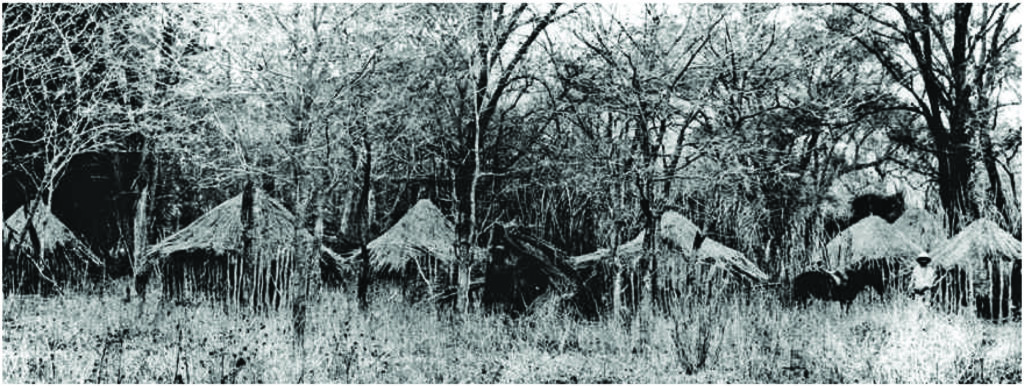
Rhodesian African village
These old breeders had many stories of grand old dogs’ feats in the bush and hunting and also had conflicting ideas as to what the RR should look like. Jack Bocock said that he thought a great temper- ament went with a dog with white and I remember standing on the pavement outside Hawley’s house, while Laurie was still finishing her tea with his wife, and him telling me and using his hands to illustrate that it was important to have, but limit the white or it would ‘creep up the leg, melt down from the chest and crawl up the neck” and then the RRs would look like Boxers. Mrs McCarthy and other breeders who never used liver noses and had beautiful clean red coats didn’t agree with Hawley at all when he said one had to breed to a liver to keep the coat clear.
We went into the veldt pretty often and in doing so would visit old farms. I remember an old Afrikaaner farmer, living by himself in his cor- rugated iron house with his pack of RR out in the sun. One old grey bitch had an unsightly bump on her neck which was obviously an in- fected DS but in spite of this she was lively and healthy. He told us that once she and he had woken a sleeping leopard in the kloof and dog and leopard leaped and locked on to each other for about 3 seconds and then both broke away and fled in opposite directions realizing that the fight would go badly for each. He said that he often came across leop- ards but apart from the dogs guarding him, they left each other alone.
Unfortunately the genes of dogs like these were lost when years lat- er the SA RR Club’s committee, without the knowledge of the mem- bers told KUSA not to register any litter of RRs unless both the par- ents were x-rayed and passed clear for HD. This was easy for the rich people who lived in the cities and showed their dogs. The poor farm- ers like the one mentioned above, probably only went shopping in their 30 year old trucks about once a month and had no hope of traveling hundreds of miles for x-rays. They loved and were proud of their dogs and even registering the pups was an effort. It was these bloodlines that Laurie did her best to save and gathered together and bred under the kennel name Lionhill.
In 1972 Mrs McCarthy retired from breeding and the Glenaholm name was passed on to Laurie and I. People do not realize just how much Laurie did for the RRs at this time. There were just not any young breeders. From a high of 400 ridge- backs who had registered pups in 1947, in 1970 only about 50 dogs had pups that were registered with KUSA. In 1972 there were only 2 cham- pions RRs made up in South Africa. Only 14 RRs from all the coun- tries of southern Africa were given the title of Champion between ’71 and ’73. The 1st show I went to there were just 3 RRs – 2 Glenaholm and 1 Rockridge.
Ridgebacks were a big part of Laurie’s life, they were in her blood, she had learnt about them from her mother’s knee, and by helping her mother with breeding plans, whelping and raising the pups, she already had 20 years’ experience. She couldn’t remember a time without them and certainly wasn’t going to let them fade away.
Laurie was a bundle of energy, encouraging owners to show their dogs and to breed, she promoted x-raying for HD and good breeding hab- its, she even rounded up the local dogs and drove them the long way to the Vet School which in those days was the only place they could be done. We rallied everyone and had showing lessons at my home and tried to make showing the dogs a pleasant and happy occasion. We made every one of our pup owners a member of the RR Club and wrote articles. Mrs McCarthy bred egg laying chickens, studied genet- ics and used it to win the World Egg Laying Record, so Laurie was far in advance of most breeders in the genetic field and would suggest studs to get the best RRs in looks and temperaments.
All these efforts were successful. New kennels were established – Shangara, Kyaphatsha, Ygdrasill and Rydgeway owned by Mrs Anne- Marie Jones Schleicher who took her Glenaholm dogs back to Hol- land with her and was very successful. In the years ’77 to ’78 there were 47 champions and the numbers went up from then. The number of dogs whose pups were registered went up to over 150 in 1980. Glena- holm made up 28 champions from ’74 to ’84.
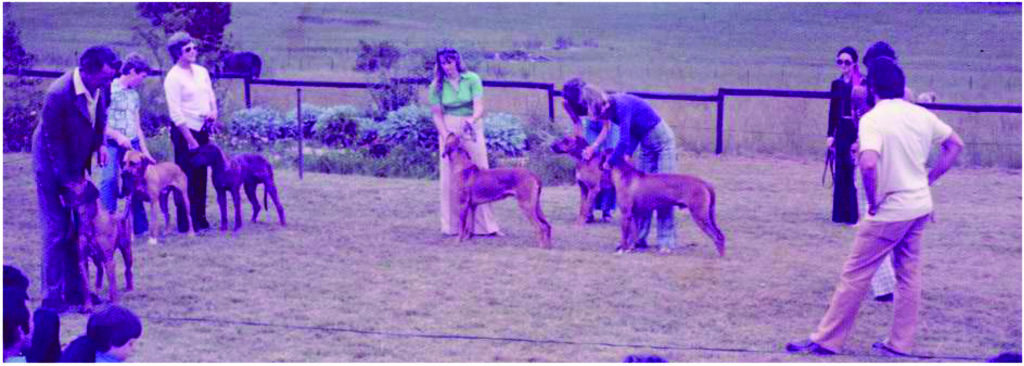
Show training at Norah’s house in the early ‘70s
To me having a Ridgie was all fun and I have to admit that without Lau- rie’s enthusiasm I would never have learnt the finer points of our breed.
What pleasure I had from my Glenaholm pack which ranged between 5 and 12 dogs. Sakaza taught my son to walk by letting him cling on to his neck skin and patiently taking one step at a time. The children rolled with them on the floor and dressed them up and I had compan- ions who came with me everyday when I rode out into the veldt where I would watch them from the vantage point on the horse as they sur- rounded hares and would slowly reduce the circumference till it had no place to escape – at which stage I would call them off as I hated to see an animal killed. I would only let them kill the spitting cobras if they were close to the house. The RR has the instinct to know just how far these could spit and would dart in and out till one saw the opportu- nity to go in and grab the back of the neck, give one shake, kill it and then have no more interest in it. Once Glenaholm Cara killed one in a small whelping kennel and we had no idea how she managed it on her own without being bitten. I didn’t know whether to be proud or very upset when one day my neighbor came over to tell me that she had borrowed my dogs to dispatch a cobra who was curled up on her back step and she couldn’t get into the house.
The RRs have a built in GPS or homing device as was demonstrated when we were out riding and we attacked by a pack of Rottweilers and I galloped off calling to the dogs. All followed but one was missing and after a long time waiting and calling I rode home in tears only to find him waiting on the patio for us. Another time I was deep in the woods and was lost for about 2 hours as it was overcast and now getting dark and I had no idea which direction home was. I mean really lost and re- ally far from home. Suddenly I realized that the dogs were with me and I asked if they would like some “dinner”. The pricked their ears, cocked their heads, turned and ran straight for home stopping only at the tops of hills to look back as if to say “hurry up Norah we are hungry”.
The Ridgie is a natural tracker. I have never taught my dogs to ‘track’ as such but when we were living adjacent to a couple of thousand acres of wooded conservation land, we played an extended version of ‘hide and seek’. I would leave the house and tell my husband to let the dogs out after half an hour and they always found me. Why half an hour? Be- cause it is lonely walking in the woods without the pack:-) There were, however, times when he forgot to open the door and it was far longer. While out walking, I never wait for my dogs if they go off after some- thing that interests them. They will always track back to me.
Once I had friends who parked on my land to go hunting and asked me to keep the dogs in the house so they would not follow, which I did. I thought it was safe to let them out a few hours later but Juba picked up their scent, and followed them down the hill, over the river, back over again, up the ridge, over the hill etc etc and found them about a mile from home as the crow flies. They weren’t amused. They have a great sense of smell and here in the US during deer hunting season, I have seen them lift their heads, sniff and take off. On these occasions I have found them camped out next to a dead deer which has unfortunately only been killed for its antlers and not removed.
I learnt to be selective when praising the dogs. I saw Juma with some- thing in his mouth with his lips all curled back and approaching him I saw that it was a curled up hedgehog. I gave him praise as I removed the little creature and put it back into the long grass. Well, he must have thought he had done something really good as just about every day after that, he presented me with a hedgehog. Who knows if it was the same one who would roll his eyes each time he saw Juma arrived and say “Oh no, not again” or if Juma was a good hedgehog tracker. I cer- tainly never saw them in the veldt.
At 3am one morning the dogs woke me because a truck drove onto the property. Of course I could not find any shoes or a flash light but went out taking only Jade with me. After arguing with the gun bearing men that they could not hunt on my land and Jade’s barking and har- assment of them getting more and more angry, they left and being so relieved I praised Jade all the way back to the house. It was the wrong thing to do as she woke barking at 3am for the next 2 weeks hoping that she was going to get the same praise.
How different things are these days from 45 years ago. What we knew we learnt from word of mouth from other breeders. If we had a prob- lem, we didn’t just Google for the answer. There weren’t any dog books readily available. My vet was rather nice and he taught me how to sew up the dogs’ wounds, and how to look for billary, a killing disease car- ried by ticks and taught me how to inject if necessary. Once a week the poor dogs were put in a tin bath filled with a cold and stinking milky dip to kill the ticks. It wasn’t a good way of preventing ticks, just killing them once they were on the dogs. How many hours I sat and pulled big fat grey ones off the dogs’ necks and little flat red ones off their bellies. How little I knew. My first dog run was made of chicken wire!! Think- ing back it lasted a pretty long time considering what damage a RR can do. I knew nothing about training a dog. Our dogs knew the basic rules of the house and the little ones learnt from the elders. At about 6 months I would put on a choke chain and with a bit of yanking taught them enough lead work to take them to shows. I had never heard of us- ing treats to train. Thankfully with that little training tool, my dogs now pick up dropped articles and close the doors behind themselves.
Dogs who were going overseas, went by ocean liners. We did a great deal of writing snail mail letters. Cameras were only used for special occasions so we have many of holidays by the sea but few of daily life and our dogs. Every now and again we might get a bad photo of a dog from some foreign land with “Temba” written on the back which doesn’t help us years later when looking through a pile of saved pho- tos. However our pup owners have always become our friends, for ex- ample I sent a breeding pair to Sirimavo Bandaranaike in Ceylon (1st lady Prime Minister in the world) and when I visited her in 1974, I stayed with her and saw the elephants working on her farm. In ’81, I made a de- tour to Brazil on the way back from the States (where I had competed in the Hot Air Balloon World Championships) to see Glenaholm Se- tabela who had become the 1st Champion in that country.
Let me impress on you that our dogs were not show dogs but mem- bers of our families who had a job of work to do. They were our guards and protectors. At night, we clapped our hands and they went outside and would alert us of anything unusual. Life for us and them was so dif- ferent from the dogs of today in 1st world countries with their green lawns and beds by the fire. Going to dog shows was an adventure if it was far away. Hotels were few and far between and they certainly wouldn’t have welcomed us and 6 Ridgebacks, so we just went till we were tired and then drove into the veldt or a field, let our dogs out, put our sleeping bags down and went to sleep feeling perfectly safe.
When we moved to the USA, it was all very strange and I thought that I would just enjoy my dogs and not breed or show again but when Laurie gave me the 2 beautiful sisters of Glenaholm Jolly Jinx who was sent to Germany, I just couldn’t resist taking them into the ring and then the requests for ‘dogs just like them’ urged me to have at least one litter. Well, we all know the joy of having pups and the delight for new owners – I was hooked once more.
Nowadays Laurie and I communicate continually and with Skype it is just like the old days when we would sit and discuss the dogs, the po- tential studs, and the outcome of our litters.
We both still have the same picture of the perfect RR in our minds and breed to maintain that look and the wonderful temperaments of the RRs we knew in the ‘60s and ‘70s.
We have often been asked how we have managed to breed for over 50 years and not lost the enthusiasm. It is the hope of breeding the perfect dog, the pleasure when someone comes back for their 4th Glenaholm dog, or when a 4th generation of a family come to carry on the tradition of having a Glenaholm dog in the family. I asked Laurie if she had ever bred a perfect dog and she said “Yes, but by the time I realized it, he wasn’t in my name. I tried to duplicate him but couldn’t.” For sure there are lots of disappointments. Suddenly you realize that the lovely round dark eyes you always had have gone and it takes you another 2 generations to get them back. You find that a dog you used 3 generations ago is throwing his one bad point and have to move away from that lineage. Mainly it is not giving up, not being disheartened by breeding mistakes and not listening to rumors and bad mouthing that mean and jealous people say about you. Laurie said, “If I had to listen to what other people thought of my dogs, I would have stopped breed- ing years ago”
It is even worse in this day and age with internet and online communi- cation. Those without experience or those who have never bred a litter can make themselves out to be experts on dog breeding and behav- ior. They can write most dreadful things about your dogs and your eth- ics. Just because something is in print, doesn’t make it correct and he who posts most is not always the most reliable person to believe. Yes, we have had some disasters but we pick ourselves up and try again. He who hasn’t a failure is either kennel blind or hasn’t bred for long.
All breeders should breed to their image of a good dog. Have an idea where you want to take your kennel and not just breed to the most popular winning dog. Build on what you have, maintain the looks and temperament of our beloved breed and don’t try to change it. I con- sider myself successful when I look at a dog and he reminds me of one I bred 40 years ago.
